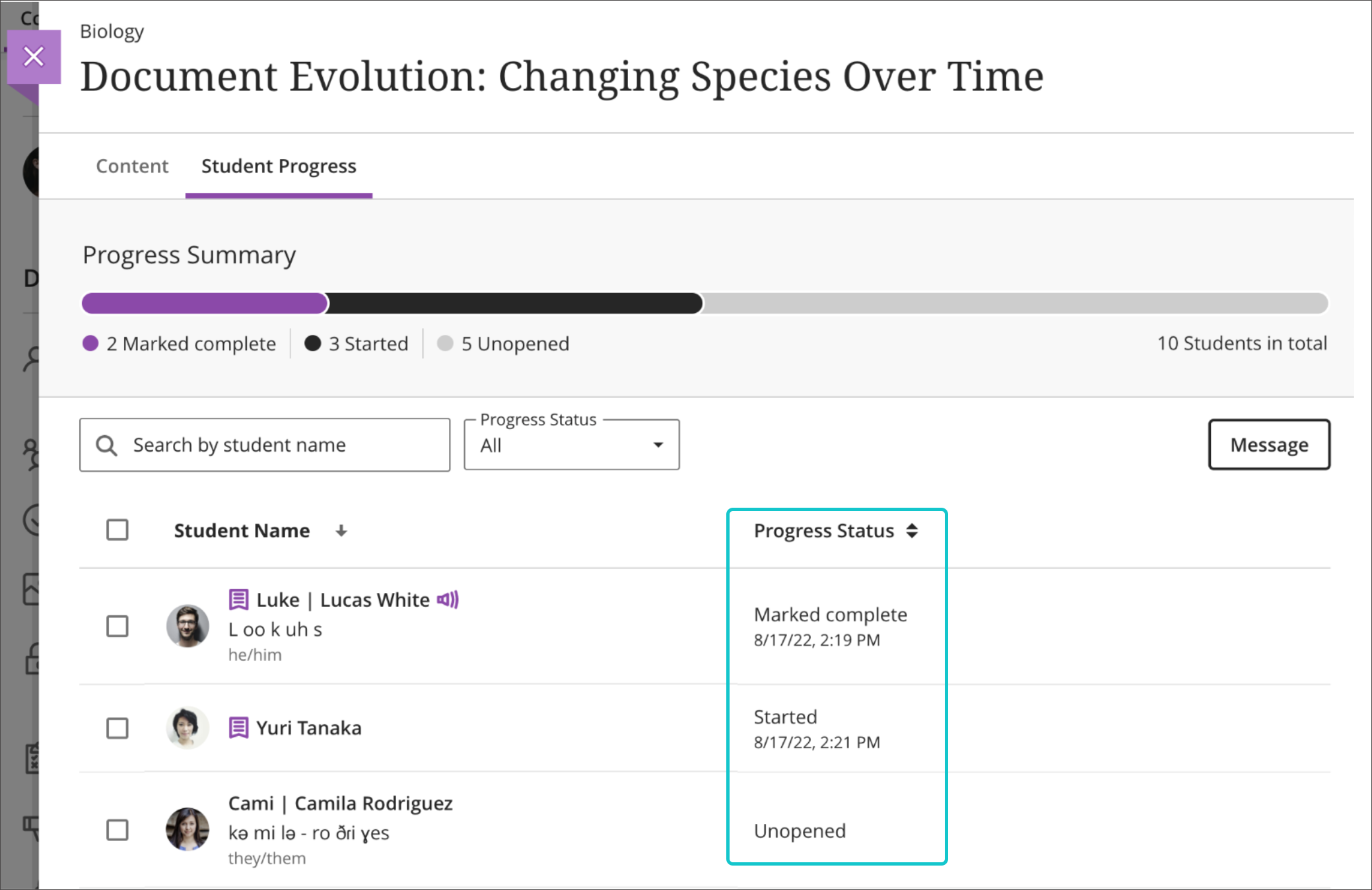Support student success with Ultra’s progress tracking tools
Discover how and when students engage with course content
The success of students in a Blackboard course is often dependent on their level of engagement and their ability to stay on track with course content and assignments. As an instructor, it's crucial to have the tools and resources to monitor students' progress and ensure they are staying engaged and motivated throughout the course.
An Ultra course provides progress tracking tools to help instructors monitor how much time students are spending in the course, what content they are engaging with, and what their current grades are. This information is invaluable in helping instructors reach out to students who may be struggling or falling behind, and it also helps in retaining students who might otherwise drop out of the course. Progress Tracking is enabled by default in all Ultra courses as of SU2023.
One of the key benefits of tracking students progress is the ability to identify potential issues early on. If a student is not engaging with course content as much as they should be, the instructor can reach out and provide support, resources, or motivation to help the student get back on track. This proactive approach can help students stay engaged and motivated, and it also helps them to understand the importance of their participation and progress in the course.

Image 1: Example of Progress Summary report. The Ultra progress tracker allows faculty to view how students are engaging with content in a course. Within the context of each content report, the instructor can easily check boxes for students who are not engaged with course resources and send a message.
Another advantage of progress tracking is the ability to monitor students' time spent in the course and where students are spending that time. Since students have the flexibility to log in and work on course content at any time, some may procrastinate or get sidetracked, leading to a decrease in their engagement and delay in completing assigned tasks. By tracking how much time students are spending in the course and seeing how and where students spend that time, instructors can intervene and provide support to help students stay on track.

Image 2: Example of Student Progress report, available from the Student Overview. Viewing an individual student's progress in the course will show how s/he has accessed all content to date and the current grade. It's also easy to send that student a message.
Additionally, tracking students' grades helps instructors to monitor their overall performance and provide additional feedback as needed. With progress tracking, instructors can easily see which students are on track for success and which students may need additional support or intervention. From the student's progress report, click on the Student Activity report to view that individual student's time spent in class and its relationship to the overall grade. Instructors can quickly send messages from these various progress tracking tools as well as within the individual submission pages for assessment activities.

Image 3: Example of Course Activity Report. This student spent more time (purple) in his winter course compared to the rest of the class (black).
Here are a few practical tips for instructors to keep in mind when using these tools:
- Leverage learning modules instead of folders. With progress tracking, students can see how much content they've completed and how much content is left to consume or finish. This can be helpful when planning their schedules or motivating to know they have just one or two items left to wrap up.
- Stay proactive. Regularly check the Student Progress report, available from the Student Overview, and reach out to those who may be struggling. Provide feedback, resources, and encouragement to help students stay on track.
- Use data to inform decisions. The data you collect from the Progress Summary report can inform your teaching and help you to make data-driven decisions about how to support your students.
- Personalize your outreach. When reaching out to students, take the time to personalize your message from assessment submissions based on their individual needs and progress. This shows that you care about their success and helps build a positive relationship with your students.
- Encourage self-reflection. Encourage students to reflect on their progress and engagement, and provide opportunities for them to share their thoughts and experiences with you and their peers.
- Celebrate successes. Celebrate and acknowledge students' successes and milestones along the way. This helps to keep students motivated and engaged in the course.
Using Ultra's progress tracking tools can be an essential part of your teaching toolkit. By tracking students' engagement, time spent, and overall grades, instructors can intervene and provide support when needed, increase engagement and motivation, and help students succeed in their coursework.
Posted: August 30, 2023, 9:11 AM
